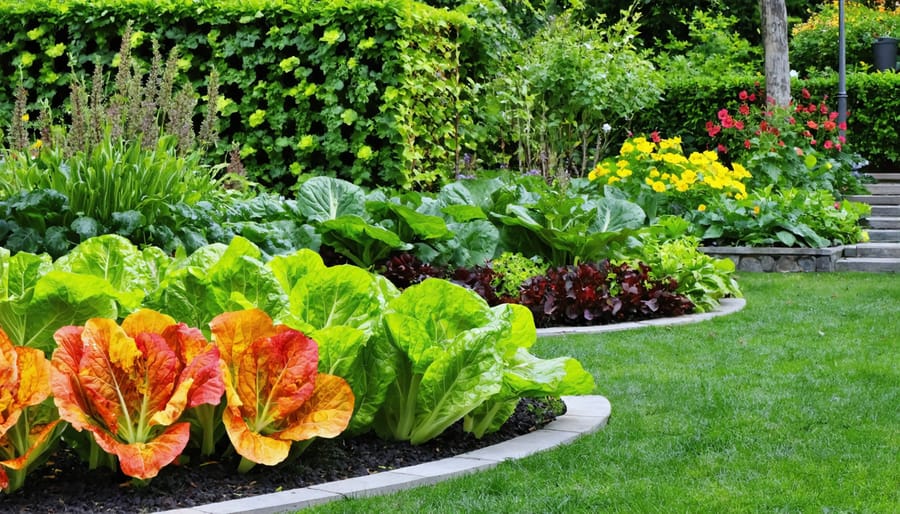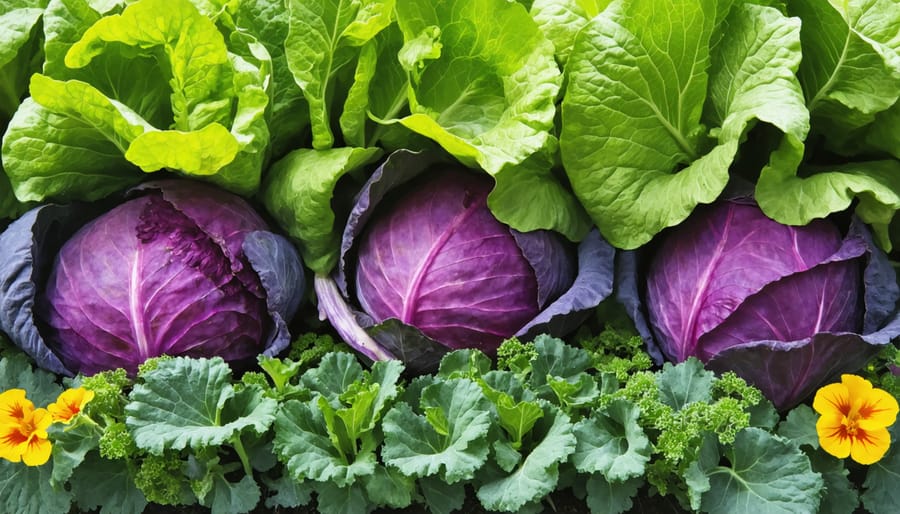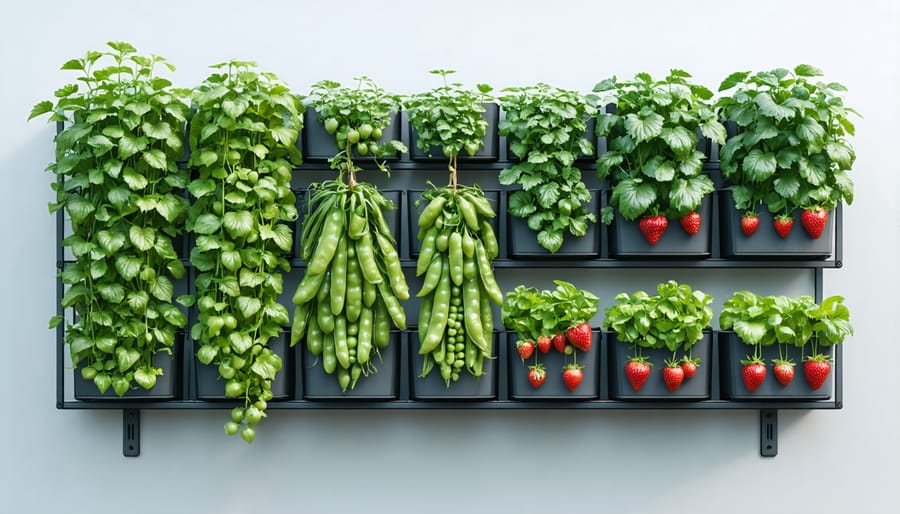Transform Your Yard Into a Beautiful Food Garden: The Art of Edible Landscaping

Transform your outdoor space into a vibrant, productive oasis with edible landscaping – the art of integrating food-producing plants into your traditional landscape design. This innovative gardening approach combines ornamental beauty with practical functionality, allowing you to harvest fresh fruits, vegetables, and herbs right from your own yard. Unlike conventional gardens that separate decorative and edible plants, edible landscaping seamlessly blends berry bushes, fruit trees, and colorful vegetables with existing flowerbeds and ornamental features. By thoughtfully incorporating edible plants into your landscape design, you create a sustainable, beautiful environment that nourishes both body and soul while maintaining the aesthetic appeal of a well-designed garden. Perfect for homeowners seeking to maximize their outdoor space, edible landscaping offers a practical solution for growing food without sacrificing the visual appeal of a traditional landscape.
What Makes a Landscape Edible?
Beyond Traditional Vegetable Gardens
Unlike traditional vegetable gardens that typically confine edible plants to rectangular plots in the backyard, edible landscaping seamlessly integrates food-producing plants throughout your entire yard. Rather than dedicating separate spaces for ornamentals and edibles, this approach combines both for a dual-purpose design. You might find strawberries serving as ground cover, grape vines creating natural privacy screens, or herb gardens bordering walkways.
What makes edible landscaping truly unique is its focus on aesthetic appeal alongside functionality. While conventional vegetable gardens often prioritize maximum yield and practical layout, edible landscapes prioritize visual harmony. Plants are selected and arranged based on their ornamental qualities – like colorful Swiss chard or flowering fruit trees – as well as their food value.
This approach transforms your entire property into a productive space while maintaining the polished look of traditional landscaping. It’s perfect for homeowners who want to make the most of limited space or those looking to create a beautiful, sustainable landscape that gives back in more ways than one.
Aesthetic Meets Function
Edible landscaping brilliantly combines beauty with practicality, transforming traditional ornamental gardens into productive spaces that please both the eye and the palate. Instead of purely decorative plants, you’ll find artistic arrangements of fruit trees, berry bushes, and colorful vegetables that create stunning visual displays while providing fresh, homegrown food. Imagine purple cabbage borders complementing flowering herbs, or espaliered apple trees forming living fences alongside climbing beans on decorative trellises.
This dual-purpose approach means every plant earns its place twice over – through its aesthetic contribution and its harvest potential. Colorful Swiss chard can replace traditional border plants, while blueberry bushes offer spring flowers, summer fruit, and spectacular fall foliage. Even compact urban gardens can become both beautiful and bountiful by incorporating dwarf fruit trees, vertical herb gardens, and ornamental vegetables into existing landscape designs. The result is a space that’s not just visually appealing but also rewards you with fresh, homegrown produce throughout the growing season.

Essential Elements of Edible Landscaping
Ornamental Edibles
One of the most delightful aspects of edible landscaping is incorporating plants that pull double duty as both beautiful ornamentals and tasty additions to your kitchen. Rainbow chard, with its vibrant, multicolored stems, creates stunning border displays while providing nutritious greens for salads. Purple basil and bronze fennel offer striking foliage that enhances flower beds while serving as aromatic herbs for cooking.
Flowering plants like nasturtiums add cheerful splashes of orange and yellow to garden beds, and their edible blooms bring a peppery kick to summer salads. Even fruit trees can serve as spectacular focal points, with spring blossoms giving way to abundant harvests. Consider espalier apple trees along a fence or a columnar cherry tree as a vertical accent.
Many edible plants naturally complement traditional landscaping elements. Strawberries make excellent ground cover, while grape vines can transform an ordinary pergola into a productive shade structure. By selecting plants that offer both visual appeal and culinary value, you’ll create a landscape that’s as practical as it is beautiful.

Structural Elements
Effective edible landscaping relies heavily on thoughtfully integrated structural elements that serve both practical and aesthetic purposes. Raised beds form the foundation of many edible landscapes, offering improved soil control, better drainage, and easier access for planting and harvesting. These elevated growing spaces can be constructed from various materials like cedar, composite boards, or stone, creating attractive borders while maximizing growing space.
Trellises and support systems play a crucial role in maximizing vertical space, particularly important for vining crops like peas, beans, and cucumbers. By implementing smart vertical gardening solutions, you can dramatically increase your growing area while adding architectural interest to your landscape.
Storage integration is another vital component, providing convenient access to tools and supplies while maintaining the garden’s visual appeal. Consider incorporating decorative tool storage benches or attractive potting stations that double as focal points. Arbors and pergolas can serve multiple purposes, supporting climbing edibles while creating intimate garden rooms or shaded seating areas.
Water features and irrigation systems should be thoughtfully incorporated into the design, ensuring both efficiency and aesthetics. Simple solutions like decorative rain barrels can capture rainwater while adding visual interest. Path systems between growing areas should be well-planned, using materials that complement your home’s architecture while providing stable footing for harvesting and maintenance activities.
Remember to include seasonal considerations in your structural planning, such as hoop houses or cold frames that can extend your growing season while maintaining the landscape’s visual appeal.
Planning Your Edible Landscape
Space Assessment
Before diving into your edible landscaping project, take time to evaluate your outdoor space carefully. Start by mapping out your yard’s sunny and shady areas, as different edible plants have varying light requirements. Note which areas receive full sun (6+ hours daily), partial sun (4-6 hours), or shade. Consider existing features like trees, structures, and hardscaping that might affect plant growth.
Assess your soil quality through a simple soil test, which will help determine what amendments you might need. Pay attention to drainage patterns in your yard – areas that stay wet or dry out quickly will influence plant selection. Don’t forget to identify accessible water sources for irrigation.
Look for vertical opportunities too, such as walls, fences, or pergolas that could support climbing edibles like grapes or pole beans. Consider your yard’s microclimates – areas that might be warmer, cooler, or more protected from wind than others.
Finally, think about traffic patterns and accessibility. You’ll want to ensure easy access to frequently harvested plants and consider how your edible landscape will integrate with existing outdoor living spaces.
Storage Solutions
A well-planned edible landscape requires thoughtful storage solutions to maintain both functionality and aesthetics. A dedicated garden shed serves as the cornerstone of your edible landscaping operation, providing essential space for organizing garden tools and supplies. When selecting a storage structure, consider one with adjustable shelving and built-in ventilation to accommodate both tools and harvested produce.
Position your shed where it’s easily accessible but doesn’t interfere with growing spaces. Include a potting bench for seedling preparation and a designated area for storing preserving supplies. Many gardeners find success with a combination of wall-mounted tool racks and mobile storage carts for frequently used items.
For harvest storage, incorporate root cellars or cool, dark spaces within your shed design. Install sturdy bins for root vegetables and dedicated spaces for canning supplies. Consider adding a small refrigeration unit for temporary storage of delicate herbs and fruits. Weather-resistant containers and proper labeling systems help maintain order and protect your tools and harvest throughout the growing season.

Benefits of Edible Landscaping
Implementing an edible landscape design offers numerous benefits that go beyond just having fresh produce at your fingertips. First, it’s a smart way to maximize your outdoor space by combining ornamental and functional elements. Instead of maintaining separate areas for flowers and vegetables, you create a unified, beautiful space that serves multiple purposes.
Financial savings are another significant advantage. By growing your own fruits, vegetables, and herbs, you can reduce your grocery bills while ensuring access to fresh, organic produce. You can even extend your growing season with proper planning and protection.
Edible landscaping also promotes environmental sustainability. These gardens reduce the carbon footprint associated with food transportation and packaging. They create natural habitats for beneficial insects and pollinators, contributing to local ecosystem health. Additionally, home-grown produce requires no commercial packaging, helping reduce plastic waste.
The educational value is particularly beneficial for families with children. Kids learn about food sources, seasonal growing cycles, and healthy eating habits through hands-on experience. This knowledge fosters a deeper connection with nature and better understanding of sustainable living practices.
From a property perspective, a well-designed edible landscape can increase your home’s value. These gardens create unique curb appeal while offering practical benefits. They also provide opportunities for community building, as neighbors often share harvests and gardening tips, fostering stronger neighborhood connections.
Edible landscaping offers a unique opportunity to transform your outdoor space into a beautiful and productive environment that nourishes both body and soul. By integrating fruits, vegetables, and herbs into your landscape design, you’re not just creating an attractive yard – you’re investing in sustainable living, better health, and potential cost savings on groceries.
Starting your own edible landscape doesn’t have to be overwhelming. Begin with a small area, perhaps near your kitchen door, and gradually expand as your confidence grows. Choose plants that match your climate and lifestyle, and remember that many edible plants are just as ornamental as their non-edible counterparts.
The rewards of edible landscaping extend beyond fresh produce. You’ll enjoy the satisfaction of growing your own food, create a more sustainable environment, and potentially increase your property value. Plus, there’s nothing quite like stepping outside to harvest fresh herbs or pick ripe tomatoes for dinner.
Ready to start your edible landscaping journey? Take that first step today – whether it’s planting a single herb in a container or planning a full garden transformation. Your future self will thank you for creating a landscape that’s both beautiful and deliciously productive.

